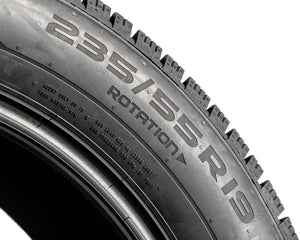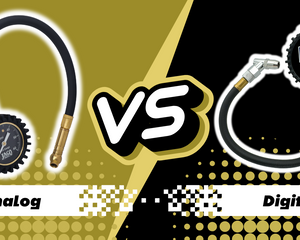
The romance of the open road, the exhilaration of a winding mountain path, the reassuring hum of a well-tuned engine - it's no surprise that we're captivated by our vehicles. But let's not forget that the key to all these automotive joys rests quite literally where the rubber meets the road. You guessed it, folks, we're talking about tires. Understanding their lifespan is not just a matter of economics - though who wouldn't want to avoid shelling out for a new set prematurely - it's also a critical aspect of both performance and safety.
How long do tires last? The U.S. Tire Manufacturers Association (USTMA) would have us believe a tire's life expectancy to be somewhere in the ballpark of six to ten years. But as we're about to delve into, it's a tad more complex than just counting off the calendar days. Strap in as we take an in-depth look at the many factors influencing your tires' lifespan.
So, what can you expect from this read? We'll be exploring everything from the impact of driving habits and road conditions, to the often overlooked role of tire maintenance. Plus, for you, the number-crunchers, we're not shying away from getting into the nitty-gritty of how manufacturers' mileage warranties play into all this. Buckle up, it's going to be an enlightening ride.

Understanding Tire Lifespan
When we talk about tire lifespan, we're not referring to how long you can store a tire in your garage. Instead, it's about the period during which a tire can perform its job effectively and keep you connected to the road. However, determining the exact lifespan of a tire can be challenging due to various factors that come into play.
Typically, tire lifespan is measured in terms of miles driven. On average, a set of tires can last anywhere between 40,000 to 60,000 miles. This range serves as a general guideline, but it's important to remember that individual tires may wear out sooner or last longer depending on several factors.
Quality and Type of Tire
First things first, not all tires are created equal. Depending on the design, technology, and materials used, some tires are simply built to last longer than others. High-performance tires, for instance, trade longevity for enhanced grip and precision handling, while long-wear touring tires are specifically engineered for durability. As a rule of thumb, more premium tires from reputable manufacturers will generally offer a longer lifespan.
Driving Habits
It's time to fess up, folks. Are you a pedal-to-the-metal type, or do you favor a smoother, more sedate driving style? Those sudden accelerations, hard stops, and high-speed cruises all take their toll on your tires. They can cause faster wear, reducing your tires' overall lifespan. In contrast, adopting a conservative driving style can help extend your tires' life expectancy.
Climate and Road Conditions
Take a moment to think about where your wheels meet the road. Potholes, speed bumps, sharp debris – it's a veritable minefield out there. Rough road conditions can lead to increased wear and potential damage, effectively cutting your tires' lifespan short. Similarly, tires exposed to extreme climates, from scorching heatwaves to freezing winters, may age prematurely.
Vehicle Type and Tire Position
It's not just about the tire itself, though. The vehicle it's fitted on plays a part too. Weight, alignment, and even the drive (front, rear, all-wheel) can influence wear patterns and the rate at which your tires age. So can the position of the tire on the car. A tire on a drive wheel, for example, will likely wear out faster than one on a free-rolling wheel. Rotating your tires regularly can help even out this wear, prolonging their useful lifespan.
Proper Tire Maintenance
Proper tire maintenance? That's your secret weapon in the battle for tire longevity. Regularly checking and adjusting your tire pressure, keeping an eye on tread depth, and promptly addressing any tire damage, can add miles to your tire's life. Consider it a labor of love, and it pays off, trust us.

Decoding the Tire Manufacturing Date
When you're thinking about the lifespan of your tires, there's one date that ought to be circled in your calendar, or rather, embossed on your sidewall: the manufacturing date. It's a crucial piece of the puzzle, often overlooked, but it could be the difference between a safe, smooth ride and an unexpected roadside rendezvous.
Tire Manufacturing Date and Where to Find It
It's not a secret code, and you don't need a magnifying glass to find it, but your tire's manufacturing date is subtly tucked away in its sidewall markings. You're looking for a four-digit number within an oval stamp, usually following the letters 'DOT'. This number is the tire's birth certificate - the week and year it was made.
Let's decode it together. If you see 'DOT 1019', it doesn't mean your tire was a fan of binary and loved the year 1019. It means it was produced in the tenth week of 2019. The first two digits represent the week, and the last two digits represent the year. Simple once you know it, right?
Why Knowing the Manufacturing Date is Important
Great, you might think, a party trick for my next get-together, but why is this date important? Well, remember, tires have a lifespan, and that clock starts ticking from the manufacturing date, not the purchase date. Even if a tire hasn't seen a minute of road time, it ages and deteriorates over time, especially if not stored correctly.
Furthermore, it's generally agreed in the industry that tires should be inspected after six years and replaced after ten, regardless of the tread left. So, the manufacturing date helps you keep track of this timeline and allows you to make informed decisions about your tire replacement schedule. After all, knowledge is power, and in this case, it's also peace of mind.

Wear and Tear: When to Replace Your Tires
Now that we've established the importance of a tire's birthdate let's discuss its retirement. Like us, tires wear out with time and use. They bear the brunt of your daily commute, weekend road trips, and those times you're running late and channel your inner race car driver. But, unlike us, a tire's life can be measured, more reliably, in its tread depth.
Tire Tread and Its Role in Tire Safety and Longevity
Tire tread isn't just there for a designer touch or to leave cool patterns on muddy roads. Its main job is to provide your vehicle with traction and evacuate water from beneath the tire to prevent hydroplaning. As the tread wears down, your tire's grip on the road diminishes, and so does your control over the vehicle, especially in wet conditions. So, monitoring your tire's tread depth is essential for maintaining your car's safety and longevity.
How to Check for Tire Wear
When it comes to checking tire wear, there are a few methods you can use. The classic "penny test" involves inserting a penny upside down into the tire grooves. If the top of Lincoln's head is visible, it indicates that the tread depth is too low, and the tire should be replaced. While the penny test can provide a quick assessment of your tire's condition, it's important to rely on more accurate measurements for a thorough evaluation.
Most safety advocates and tire manufacturers recommend replacing your tires when they reach a tread depth of 4/32 inch. This is particularly crucial if you frequently drive in wet or snowy conditions, where proper traction is essential for safety. While visual inspections like the penny test can give you a rough idea of your tire's condition, investing in a reliable tire tread depth gauge offers more precision and accuracy.
Using a tire tread depth gauge allows you to measure the depth of the grooves with greater accuracy, giving you a precise reading of your tire's remaining tread life. By staying proactive and replacing your tires at the recommended tread depth, you'll ensure optimal safety and performance on the road, regardless of the driving conditions you encounter.
The Role of Tire Maintenance in Extending Lifespan
Proper tire maintenance is the unsung hero of your tire's lifespan. It doesn't get the limelight, but boy does it do the heavy lifting. Let's delve a bit deeper into the impact of tire pressure, alignment, rotation, and balancing on your tire's lifespan.
Importance of Proper Tire Maintenance
Tire maintenance is not just a box to check on your car care to-do list. It's crucial for keeping your tires in top shape and, more importantly, keeping you and your passengers safe on the road. Maintaining your tires can also improve your vehicle's fuel efficiency and performance. So, it's a win-win.
Impact of Tire Pressure, Alignment, Rotation, and Balancing on Tire Lifespan
First off, tire pressure. Just right, and your car is a dream to drive; too low or too high, and your tires will wear out faster and unevenly. It's a simple check that can make a world of difference.
Next up, alignment. Think of it as a chiropractor for your car. A well-aligned vehicle ensures your tires meet the road at the proper angle, extends their lifespan, and improves handling.
Now, let's talk rotation. By regularly rotating your tires, you can ensure they wear evenly, prolonging their life and giving you a smoother ride.
Lastly, balancing. Over time, tires can become unbalanced, leading to vibration, uneven wear, and premature tire wear. Regularly balancing your tires can rectify this and contribute to a longer tire lifespan.
In conclusion, treat your tires like a valued member of your family. Keep an eye on their pressure, ensure they're well aligned, rotate them regularly, and keep them balanced. They'll repay you with a safe, smooth, and efficient drive.

Recognizing the Warning Signs of Aging Tires
What are the Signs of Aging in a Tire?
As tires age, they undergo physical and chemical changes that can impact their performance and safety. Here are some warning signs to look out for:
- Cracks or bulges on the sidewall: These can indicate structural weakness and potential tire failure.
- Uneven tread wear: If your tire tread is wearing unevenly, it could be a sign of alignment issues or tire imbalances.
- Loss of grip and traction: As tires age, the rubber compound hardens, reducing their ability to grip the road.
- Tire vibrations: Excessive vibrations can indicate tire imbalances or internal damage.
- Excessive dry rot: Dry, brittle, or discolored sidewalls may indicate aging and deterioration.
Dangers Associated with Driving on Old Tires
Driving on old or deteriorating tires can pose significant risks:
- Reduced traction: Worn-out tires have less grip on the road, increasing the risk of skidding and loss of control, particularly in wet or snowy conditions.
- Inadequate braking performance: Tires with reduced tread depth take longer to stop, compromising your ability to brake safely.
- Tire blowouts: Aging tires are more prone to sudden failures, leading to dangerous blowouts that can cause accidents.
- Increased risk of hydroplaning: As tire tread wears down, water cannot be effectively dispersed, increasing the risk of hydroplaning and loss of steering control.

The Cost Factor: Tire Lifespan vs. Tire Price
Finding the Balance
When it comes to purchasing new tires, there's a delicate balance between lifespan and price. Consider these factors:
- Tire Quality: Higher-quality tires tend to have longer lifespans due to better construction, tread compounds, and advanced technologies.
- Driving Habits: Your driving style and conditions can influence tire wear. Aggressive driving, frequent heavy loads, and rough road conditions can shorten tire lifespan.
- Budget Considerations: While durable tires may come with a higher price tag upfront, they often provide better value in the long run due to extended lifespan and performance.
Considerations When Buying New Tires (Longevity vs. Initial Cost)
When choosing new tires, it's essential to strike a balance between longevity and initial cost:
- Assess Your Needs: Consider your driving habits, mileage, and weather conditions to determine the appropriate tire lifespan required.
- Research Tire Reviews: Read customer and expert reviews to gather insights on the lifespan and performance of different tire models.
- Consider Value Proposition: Evaluate the overall value, taking into account factors such as performance, fuel efficiency, and safety features alongside the initial cost.
- Consult a Professional: Seek advice from a trusted tire professional who can guide you based on your specific requirements and budget.
Remember, finding the right balance between tire lifespan and price ensures both your safety on the road and long-term cost-effectiveness.
Final Thoughts
In this comprehensive guide, we've explored the factors that influence tire lifespan and the importance of maintaining your tires for safety and longevity. Let's recap the key points:
Tire lifespan is influenced by various factors, including tire quality, driving habits, climate, road conditions, vehicle type, and proper tire maintenance. Understanding these factors can help you maximize the lifespan of your tires and ensure optimal performance on the road.
Checking tire tread depth, recognizing signs of aging, and conducting regular maintenance are crucial for safe driving. It's essential to monitor tire wear, maintain proper tire pressure, perform regular alignments and rotations, and address any issues promptly.
When it's time to replace your tires, consult with professionals who can provide expert advice tailored to your specific needs. They can guide you in selecting the right tires based on your driving habits, climate, and budget.
Remember, the longevity of your tires is directly linked to your safety on the road. Regular inspections, maintenance, and timely replacements will not only ensure your safety but also extend the lifespan of your tires, saving you money in the long run.
Don't compromise on tire maintenance and safety. Consult with professionals, follow best practices, and enjoy confident and comfortable journeys on the road.
Check Out Our Essential Tire Maintenance Tools
Proper tire maintenance requires the right tools to ensure accurate measurements and efficient adjustments. At JACO, we offer a range of high-quality tire maintenance tools to help you keep your tires in optimal condition. Here are some must-have tools you can find in our shop:
Tire Tread Depth Gauge
A tire tread depth gauge is an indispensable tool for assessing the condition of your tires. Check out our selection of tread depth gauges that provide precise measurements, allowing you to determine when it's time to replace your tires.
Tire Inflators
Ensure your tires are properly inflated with our reliable tire inflators. From handheld models to digital inflators, our collection offers user-friendly options that deliver accurate air pressure for safe and efficient driving.
Tire Pressure Gauges
Accurate tire pressure is essential for optimal tire performance and longevity. Explore our range of tire pressure gauges, including digital and analog options, designed to provide accurate readings and help you maintain the correct tire pressure for your vehicle.
Visit our online shop to discover these essential tire maintenance tools and more. Our products are built to meet the highest standards of quality and durability, ensuring that you have the right tools to keep your tires in top shape.
Don't compromise on tire maintenance. Invest in the right tools today and enjoy safer, more efficient travels on the road.





